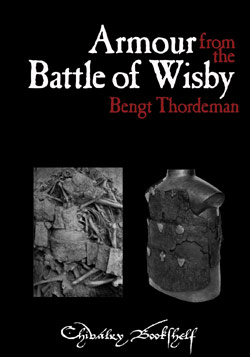We all know that we find lot of coat of plate in Visby, but do we find lot of mail too ?
I mean, do they wear coat of plate without mail most of the time ? Because mail was much more expensive than plates ?
Thanks for reading
Alexis
There were remains of 200-300 mail coifs, making them the most common armor found at Wisby. There are a couple of mail forearm guards (musekins?), and only a few complete shirts. You must remember this was a rural militia, many of whom may have had no armor at all. While the knightly class might have worn plates over mail and aketon, the lower classes might have only had plates and an aketon at best.
Randall Storey has several price comparisons. The major cost factor on the pairs of plates is the covering and material for nails and buckles. The variance in costs of mail includes material (iron vs. steel), size of rings, and area covered. The prices of the two could be comparable, though higher quality of either will be more than the lowest quality of the other.
Also keep in mind that mail corrodes more readily due to the larger exposed surface, so when it's is found, it often appears as nothing more than red gravel.
Randall Storey has several price comparisons. The major cost factor on the pairs of plates is the covering and material for nails and buckles. The variance in costs of mail includes material (iron vs. steel), size of rings, and area covered. The prices of the two could be comparable, though higher quality of either will be more than the lowest quality of the other.
Also keep in mind that mail corrodes more readily due to the larger exposed surface, so when it's is found, it often appears as nothing more than red gravel.
Last edited by Mart Shearer on Sat 20 Feb, 2016 6:46 am; edited 1 time in total
If you want info on Wisby armor, get this book. It's basically an archeological reference on the armor.
http://www.bookfinder.com/search/?ac=sl&s...C%25201361
 Attachment: 21.65 KB
Attachment: 21.65 KB

http://www.bookfinder.com/search/?ac=sl&s...C%25201361

Last edited by Harry Marinakis on Sun 21 Feb, 2016 4:12 am; edited 1 time in total
Online copy of the first edition:
Volume 1: http://michael-engel.io.ua/album329328_0
Volume 2: http://michael-engel.io.ua/album331513
One of the mail shirts:
http://io.ua/13608173p
Volume 1: http://michael-engel.io.ua/album329328_0
Volume 2: http://michael-engel.io.ua/album331513
One of the mail shirts:
http://io.ua/13608173p
If they found a couple of hundred mail coifs at Visby, I'd have expected a least a couple of dozen mail hauberks to have survived - after all, preservation conditions would have been pretty similar, So, to my reasoning, the lack of much mail body armour indicated that they weren't wearing it. Does that sound a reasonable assumption on my part ?
If they found a couple of hundred mail coifs at Visby, I'd have expected a least a couple of dozen mail hauberks to have survived - after all, preservation conditions would have been pretty similar, So, to my reasoning, the lack of much mail body armour indicated that they weren't wearing it. Does that sound a reasonable assumption on my part ?
| Ralph Grinly wrote: |
| If they found a couple of hundred mail coifs at Visby, I'd have expected a least a couple of dozen mail hauberks to have survived - after all, preservation conditions would have been pretty similar, So, to my reasoning, the lack of much mail body armour indicated that they weren't wearing it. Does that sound a reasonable assumption on my part ? |
Or it was worth looting after the battle unlike coifs.
| Ralph Grinly wrote: |
| If they found a couple of hundred mail coifs at Visby, I'd have expected a least a couple of dozen mail hauberks to have survived - after all, preservation conditions would have been pretty similar, So, to my reasoning, the lack of much mail body armour indicated that they weren't wearing it. Does that sound a reasonable assumption on my part ? |
Consider that many of the coifs were unrecoverable, having been reduced to a layer of rust-colored "gravel" on a skull.
Thordeman mentions 2 or 3 mail "shirts" in common grave 1, and another 9 mail "shirts" in common grave 2, so there's a dozen. The problem is that the mail fragments discovered were too large to be coifs, but too corroded to positively identify them as shirts. Some might have been paunces or sleeves, for example. Interestingly, most of the mail shirts in grave 2 are buried near the edge of the pit, so weight might have been a consideration in disposal of the corpses.
As I understand it..after the battle, the victors continued to chase the surviving losers. By the time anyone returned to the battlefield, the bodies were too badly decomposed to strip them of the armour, The remains were simply shovelled into pits and left, hence the survival of the coats of plates and coifs. Yes, there were some probable mail armours there when excavated..but no-where near the numbers compared to the coifs.
That a lot of maille was found at Wisby indicates that in the hot sun the bodies were too bloated to strip them of their armor before covering them with dirt, the sight and smell of which I care not to imagine.
Page 1 of 1
You cannot post new topics in this forumYou cannot reply to topics in this forum
You cannot edit your posts in this forum
You cannot delete your posts in this forum
You cannot vote in polls in this forum
You cannot attach files in this forum
You can download files in this forum
All contents © Copyright 2003-2006 myArmoury.com — All rights reserved
Discussion forums powered by phpBB © The phpBB Group
Switch to the Full-featured Version of the forum
Discussion forums powered by phpBB © The phpBB Group
Switch to the Full-featured Version of the forum